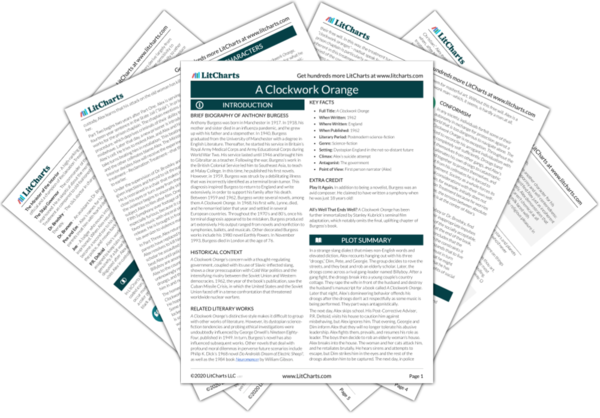Welcome to the LitCharts study guide on Anthony Burgess's A Clockwork Orange. Created by the original team behind SparkNotes, LitCharts are the world's best literature guides.
A Clockwork Orange: Introduction
A concise biography of Anthony Burgess plus historical and literary context for A Clockwork Orange.
A Clockwork Orange: Plot Summary
A quick-reference summary: A Clockwork Orange on a single page.
A Clockwork Orange: Detailed Summary & Analysis
In-depth summary and analysis of every chapter of A Clockwork Orange. Visual theme-tracking, too.
A Clockwork Orange: Themes
Explanations, analysis, and visualizations of A Clockwork Orange's themes.
A Clockwork Orange: Quotes
A Clockwork Orange's important quotes, sortable by theme, character, or chapter.
A Clockwork Orange: Characters
Description, analysis, and timelines for A Clockwork Orange's characters.
A Clockwork Orange: Symbols
Explanations of A Clockwork Orange's symbols, and tracking of where they appear.
A Clockwork Orange: Theme Wheel
An interactive data visualization of A Clockwork Orange's plot and themes.
Brief Biography of Anthony Burgess
Anthony Burgess was born in Manchester in 1917. In 1918, his mother and sister died in an influenza pandemic, and he grew up with his father and a stepmother. In 1940, Burgess graduated from the University of Manchester with a degree in English Literature. Thereafter, he started his service in Britain’s Royal Army Medical Corps and Army Educational Corps during World War Two. His service lasted until 1946 and brought him to Gibraltar as a teacher. Following the war, Burgess’s work in the British Colonial Service led him to Southeast Asia, to teach at Malay College. In this time, he published his first novels. However, in 1959, Burgess was struck by a debilitating illness that was incorrectly identified as a terminal brain tumor. This diagnosis inspired Burgess to return to England and write extensively, in order to support his family after his death. Between 1959 and 1962, Burgess wrote several novels, among them A Clockwork Orange. In 1968, his first wife, Lynne, died, and he remarried later that year and settled in several European countries. Throughout the 1970’s and 80’s, once his terminal diagnosis appeared to be mistaken, Burgess produced art extensively. His output ranged from novels and nonfiction to symphonies, ballets, and musicals. Other decorated Burgess works include his 1980 novel Earthly Powers. In November 1993, Burgess died in London at the age of 76.
Get the entire A Clockwork Orange LitChart as a printable PDF.

Historical Context of A Clockwork Orange
A Clockwork Orange’s concern with a thought-regulating government, coupled with its use of Slavic-inflected slang, shows a clear preoccupation with Cold War politics and the intensifying rivalry between the Soviet Union and Western democracies. 1962, the year of the book’s publication, saw the Cuban Missile Crisis, in which the United States and the Soviet Union faced off in a tense confrontation that threatened worldwide nuclear warfare.
Other Books Related to A Clockwork Orange
A Clockwork Orange’s distinctive style makes it difficult to group with other works of literature. However, its dystopian science-fiction tendencies and probing ethical investigations were undoubtedly influenced by George Orwell’s Nineteen Eighty-Four, published in 1949. In turn, Burgess’s novel has also influenced subsequent works. Other novels that deal with profound moral dilemmas in perverse future scenarios include Philip K. Dick’s 1968 novel Do Androids Dream of Electric Sheep?, as well as the 1984 book Neuromancer by William Gibson.
Key Facts about A Clockwork Orange
- Full Title: A Clockwork Orange
- When Written: 1962
- Where Written: England
- When Published: 1962
- Literary Period: Postmodern science-fiction
- Genre: Science-fiction
- Setting: Dystopian England in the not-so-distant future
- Climax: Alex’s suicide attempt
- Antagonist: The government
- Point of View: First person narrator (Alex)
Extra Credit for A Clockwork Orange
Play It Again. In addition to being a novelist, Burgess was an avid composer. He claimed to have written a symphony when he was just 18 years old!
All’s Well That Ends Well? A Clockwork Orange has been further immortalized by Stanley Kubrick’s seminal film adaptation, which notably omits the final, uplifting chapter of Burgess’s book.












